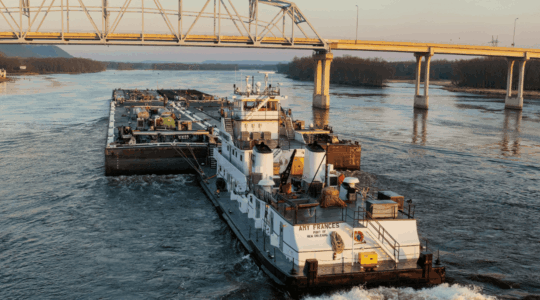Marine
Pollution Risk Management for U.S. Shipyards and Vessel Owners
Current Exposures and Future Environmental Challenges
January 14, 2025
The U.S. maritime industry—especially shipyards and vessel owners—faces unique and intensifying pollution risks due to regulatory demands, environmental pressures, and the complexity of managing fuel, storage, and waste systems. Identifying these pollution exposures, implementing targeted risk management strategies, and anticipating future environmental challenges are essential to maintaining compliance, operational efficiency and environmental stewardship.
Identifying Marine Pollution Exposures in Shipyards and Vessels
To craft an effective risk management plan, shipyards and vessel owners must first understand the environmental exposures inherent in their industry. Fuel storage and transfer pose some of the greatest risks for pollution incidents. Aboveground and underground storage tanks present a unique risk of leaks, spills and long-term soil contamination. The pipelines that transfer fuel to and from these tanks, especially at coupling points, are also vulnerable to integrity failures, which can lead to significant leaks.
Operational and maintenance activities further heighten these risks. For instance, fuel spills frequently occur during vessel loading and refueling operations, posing immediate contamination risks. Additionally, bilge water management requires careful attention, as bilge water often contains oil and other contaminants that, if improperly discharged, can severely impact surrounding waters. In older shipyards or aging vessels, the presence of hazardous materials like asbestos and PCBs present another pollution hazard, particularly when these materials are disturbed during repairs or routine maintenance.
Beyond material storage and handling, the industry must contend with the implications of compliance with emissions and discharge standards. Combustion emissions from fuel-burning marine vessels must meet strict regulatory requirements, and any pollution from shipyard activities risks accumulating in stormwater runoff and potentially polluting nearby waters. These pollution exposures underscore the importance of diligent management and compliance efforts in minimizing risk.
Risk Management Strategies for Marine Pollution
For shipyards and vessel owners, risk management is about proactive action, from operational best practices to emergency response preparedness. One of the foundational steps in any environmental risk management strategy is establishing a robust inspection and maintenance schedule. Routine inspections help to detect leaks or other vulnerabilities in fuel tanks and pipelines before they lead to major incidents. Integrity testing of pipelines and careful examination of coupling points should also be a part of this regular maintenance, ensuring secure fuel transfers and preventing accidental spills. If your risk management strategy is to insure these exposures, be sure policies are structured appropriately. For example, underground storage tanks will need to be scheduled, and you’re likely to see higher deductibles associated with older tanks and pipelines.
Investing in containment systems and spill response equipment is essential for spill prevention and mitigation. Secondary containment systems—installed at fuel storage areas, transfer points, and piers—serve as a critical safeguard by capturing leaks or spills before they reach the environment. A well-defined spill response plan, combined with adequate training, equips personnel to act swiftly in the event of an incident. This rapid response capability is crucial for minimizing environmental damage and maintaining regulatory compliance.
Compliance audits and environmental assessments are also valuable tools for assessing pollution risks and identifying gaps in compliance. Routine assessments can help ensure that practices meet federal and state environmental standards and can point out areas where additional risk reduction efforts may be warranted.
Specialized environmental coverage, such as site pollution policies for shipyards or vessel pollution liability insurance, can provide financial protection for shipyards and vessel owners covering a range of incidents from spills to loss of business income to natural resource damage. Note that certain pollution exposures, such as asbestos and PCBs, will be more difficult to insure and will be more heavily underwritten.
Another consideration would be third parties, such as a dredging contractor, entering your site and performing services on your behalf. To properly manage any pollution incidents they could create, you should require that they evidence an occurrence form Contractors Pollution Liability and name you as an additional insured, with their policy being primary over any other collection coverage.
Operational best practices and employee training complete the risk management framework. Employees should receive training on safe fueling and bilge water discharge procedures, as well as proper housekeeping and waste management protocols. Well-informed and proactive personnel are better equipped to prevent accidental spills or mishandling of hazardous materials.
Preparing for Future Environmental Challenges in the Maritime Industry
Looking ahead, shipyards and vessel owners must stay attuned to emerging environmental issues that may impact the maritime industry. Perhaps the most significant of these challenges will be stricter regulations around carbon emissions and greenhouse gases. As the push for decarbonization intensifies, the industry may face mandates to transition to alternative fuels, such as LNG or biofuels, or to explore new technologies, including electric power for smaller vessels and port machinery.
Plastic pollution, another growing concern, may soon see increased regulatory oversight, especially for single-use plastics, packaging waste, and maintenance materials. Shipyards and vessels might be called upon to reduce plastic use or implement “zero-waste” practices to limit plastic pollution in oceans and waterways.
The maritime industry must also consider strategies for responding to rising sea levels and extreme weather events. Shipyards along coastlines, for example, may need to adopt floodproofing measures or reinforce docks to withstand storm surges, ensuring that facilities can continue operating despite climate-related disruptions.
Another future focus will likely be enhanced biodiversity protection and marine habitat conservation. Regulators are increasingly attentive to ballast water discharge practices, bilge cleaning and anchoring methods to prevent the spread of invasive species and protect sensitive marine ecosystems. Digital monitoring technologies will also play an expanding role in environmental compliance. Internet of Things sensors and automated monitoring systems can provide real-time data on emissions, discharges and pollution levels, facilitating early detection of potential issues and offering increased transparency for regulators.
Finally, sustainable ship recycling is poised to become a critical issue as more vessels reach the end of their service lives. Shipyards may face new requirements for eco-friendly dismantling and disposal processes, reclaiming valuable materials and reducing environmental impact. By integrating sustainable recycling practices, shipyards can reduce pollution risks and contribute to a circular economy in the maritime sector.
Conclusion
Effective pollution risk management is essential for U.S. shipyards and vessel owners as they navigate an increasingly complex regulatory landscape. From comprehensive inspection programs and containment systems to specialized environmental coverage and proactive training, today’s risk management strategies equip shipyards and vessel owners to mitigate pollution exposures and fulfill compliance requirements. The industry must also prepare for emerging environmental challenges, from decarbonization and plastic pollution reduction to climate adaptation and sustainable ship recycling.
By adopting forward-thinking practices and adapting to these evolving pressures, shipyards and vessel owners can position themselves as leaders in environmental stewardship, gaining a competitive edge and a lasting reputation for responsibility within the maritime industry.
Learn more about Hylant’s marine practice here.
The above information does not constitute advice. Always contact your insurance broker or trusted advisor for insurance-related questions.


